Jackfruit Nutrition Facts
Jackfruit is one of its own kind of tropical fruits, recognized for its unique shape, size, and fruity flavor that can be appreciated from a distance. The fruit is delicious sweet taste. In common with other tropical fruits such asdurian, banana, etc., it is also rich in energy, dietary fiber, minerals, and vitamins and free from saturated fats or cholesterol, making it one of the healthy summer treat to relish!
Botanically, this popular Asian tropical fruit belongs to the family of moraceae, genus: Artocarpus and is closely related to figs, mulberry, and breadfruit. Scientific name: Artocarpus heterophyllus.
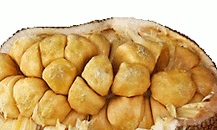 |
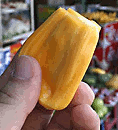 |
| Jackfruit - inside with edible bulbs. | Golden-yellow color edible bulb. (Photo courtesy: laughlin) |
Jackfruit is a huge tree that grows to as high as 30 meters, larger than mango tree. It is believed to be indigenous to the Southwestern rain forests of India. Today, it is widely cultivated in the tropical regions of Indian subcontinent, Thailand, Malaysia, Indonesia and Brazil for its fruit, seeds, and wood. The tree grows best under tropical humid and rainy climates but rarely survives cold and frosty conditions.
During the season, each tree bears as many as 250 large fruits, supposed to be the largest tree-borne fruits in the world. The fruit varies widely in size, weigh from 3 to 30 kg, and has oblong or round shape measuring 10 cm to 60 cm in length, 25 to 75 cm in diameter. While unripe fruits are green, they turn light brown and spread a strong sweet, fruity smell once ripe.
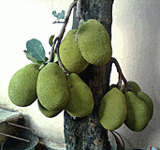 |
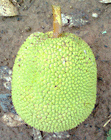 |
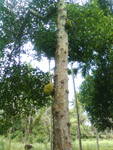 |
| Jackfruit tree with large produce. | Jackfruit (Artocarpus heterophyllus). | Jackfruit tree. |
As in durian fruit, its outer surface is covered with the blunt thorn-like projections, which become soft as the fruit ripe.
Its interior consists of orange-yellow colored edible bulbs. Each bulb consists of sweet-flavored flesh (sheath) that encloses a smooth, oval, light-brown seed. There may be as many as 100 to 500 edible bulbs embedded in a single fruit interspersed between thin bands of fibers.
Jackfruit seed is encased inside a thin, transparent outer cover. It largely compose of starch and white and crisp within. Each seed measures about 2 to 4 cm in length, and 1 to 3 cm in thickness.
Almost all the parts of the tree secrete white sticky latex like milk (juice) upon infliction of injury.
Health benefits of jackfruit
-
100 g of edible jackfruit bulbs provide 95 calories. The fruit is made of soft, easily digestible flesh (bulbs) with simple sugars like fructose and sucrose that when eaten replenishes energy and revitalizes the body instantly.
-
Jackfruit is rich in dietary fiber, which makes it a good bulk laxative. The fiber content helps protect the colon mucous membrane by binding to and eliminating cancer-causing chemicals from the colon.
-
Fresh fruit has small amounts of vitamin-A, and flavonoid pigments such as carotene-ß, xanthin, lutein and cryptoxanthin-ß. Together, these compounds play vital roles in antioxidant and vision functions. Vitamin A is also required for maintaining integrity of mucus membranes and skin. Consumption of natural fruits rich in vitamin-A, and carotenes has been found to protect from lung and oral cavity cancers.
-
Additionally, jackfruit is a good source of antioxidant vitamin-C, provides about 13.7 mg or 23% of RDA. Consumption of foods rich in vitamin C helps the body develop resistance against infectious agents and scavenge harmful free radicals.
-
It is one of the rare fruits that is rich in B-complex group of vitamins. It contains very good amounts of vitamin B-6 (pyridoxine), niacin, riboflavin, and folic acid.
-
Fresh fruit is a good source of potassium, magnesium, manganese, and iron. Potassium is an important component of cell and body fluids that helps controlling heart rate and blood pressure.
Jackfruit seeds
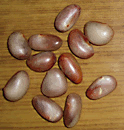 |
Jackfruit seeds are indeed very rich in digestible starch, protein and minerals. In general, the seeds are gathered from the ripe fruit during summer, sun-dried and stored for use in rainy season in many parts of South Indian states. Again, in these areas, jackfruit seeds can be employed in variety of recipes where they generally are eaten either by roasting as a snack or added to stews (curries) in place of lentils.
| Principle | Nutrient Value | Percentage of RDA |
|---|---|---|
| Energy | 95 Kcal | 5% |
| Carbohydrates | 23.5 g | 18% |
| Protein | 1.72 g | 3% |
| Total Fat | 0.64 g | 3% |
| Cholesterol | 0 mg | 0% |
| Dietary Fiber | 1.5 g | 4% |
| Vitamins | ||
| Folates | 24 µg | 6% |
| Niacin | 0.920 mg | 6% |
| Pyridoxine | 0.329 mg | 25% |
| Riboflavin | 0.055 mg | 4% |
| Thiamin | 0.105 mg | 9% |
| Vitamin A | 110 IU | 3.5% |
| Vitamin C | 13.7 mg | 23% |
| Vitamin E | 0.34 mg | 2% |
| Electrolytes | ||
| Sodium | 3 mg | 0% |
| Potassium | 303 mg | 6.5% |
| Minerals | ||
| Calcium | 34 mg | 3.4% |
| Iron | 0.60 mg | 7.5% |
| Magnesium | 37 mg | 9% |
| Manganese | 0.197 mg | 8.5% |
| Phosphorus | 36 mg | 5% |
| Phosphorus | 21 mg | 3% |
| Selenium | 0.6 mg | 1% |
| Zinc | 0.42 mg | 4% |
| Phyto-nutrients | ||
| Carotene-ß | 61 µg | -- |
| Crypto-xanthin-ß | 5 µg | -- |
| Lutein-zeaxanthin | 157 µg | -- |
Selection and storage
Jackfruit is a summer season fruit that coincides with other tropical commoners like mango, durian, and mangosteen.
In the stores, buy fruit that emits mild yet rich flavor and just yields to thumb pressure. Thorn-like projections becomes soft in case of the ripe fruit. Once ripen, the fruit deteriorates rather quickly unless its processed arils (bulbs) stored inside the refrigerator.
Preparation and serving method
The fruit is cut in a similar fashion like other larger fruits likewatermelon. White, gummy latex oozes from the cut ends even in ripe fruit but to a lesser extent. This latex problem can be overcome by applying little coconut oil on the hands while separating bulbs since protective gloves would not help.
Another great way of dealing with this problem is mopping or rubbing the cut sections with lemon slice. The thick rind that runs through the middle of the fruit is then removed, and the whole section is gently twisted few turns in order to loosen individual bulbs.
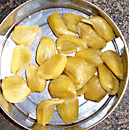 |
Each edible bulb is made of thick orange-yellow flesh; cut open it with small knife or split the bulb with fingertips vertically. Inside each bulb, you find a thick light brown color seed; keep it aside and enjoy the delicious flesh (sheath).
Here are some serving tips:
-
Jackfruit bulbs have unique flavor and sweet taste. Enjoy them without any additions in order to experience their rich taste.
-
Jackfruit slices hand-mixed with grated coconut, honey, banana slices is one of the wonderfully delicious dessert preparations commonly served on festive occasions in southern parts of India.
-
The fruit is also used in jam, jelly and chutney preparations.
-
Fruit slices are a great addition to fruit salad.
-
Jackfruit seeds are a good source of protein and minerals; used like vegetables and pulses in curry (sabzee) preparation in several Asian countries.
-
Unripe green fruit is employed like vegetable in the preparation known as "kathal sabzee" in some North Indian states and "sayur nangka" in Indonesia.



